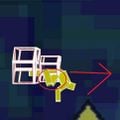Captain Falcon (SSB)/Up aerial
From SmashWiki, the Super Smash Bros. wiki
Jump to navigationJump to search
Overview

The hitbox of Captain Falcon's up aerial.
Captain Falcon does a flip kick in the air. A very versatile attack, being very useful for combos, and on par with Pikachu's up aerial for being the best aerial attack in the game. Depending on what part of the hitbox hits, it can send the opponent at different angles:
- The heel launches upwards, with the largest hitbox, and can be chained into itself multiple times to rack up damage, with multiple combo finisher options available. The most common are Falcon Dive (which can easily KO offstage due to sending opponents a difficult-to-DI diagonal upward trajectory, and can also Star KO near the upper blast line at any part of the stage) and down aerial (which is an effective edgeguarding option, and could be considered a Ken Combo variation). Other combo finishers available are the Falcon Punch in certain situations, and the up aerial with the semi-spike portion of the hitbox landed (back of his foot/the heel).
- The mid-section of the leg launches forwards, with a medium-sized hitbox. This part of the hitbox while Falcon is moving back hits the opponent backwards at an angle, again with a medium-sized hitbox. Neither of them are very easy to land, and neither are seen too much in competitive play.
- The back of his foot/the heel launches at a 180 degree angle backwards, with a small hitbox and semi-spike properties, meaning that it is rather useful and effective for edgeguarding. Not too difficult to land, can intercept certain recoveries such as Pikachu's Quick Attack and Fox's Fire Fox. This part of the attack, in fact, has two separate "sub-parts" - it can also send opponents at a slightly higher angle with a bit less knockback if it hits earlier/higher, along with the usual low angle.
- His shoulder launches at a 180 degree angle forwards, again being a semi-spike, but being incredibly difficult to time and land, and so rarely ever seen in competitive play. Theoretically it could be pretty useful for edgeguarding when the other semi-spike portion of the move is not available.
Gallery
SuPeRbOoMfAn (Captain Falcon) performing the Stairway to Heaven on Isai (Link).
|



